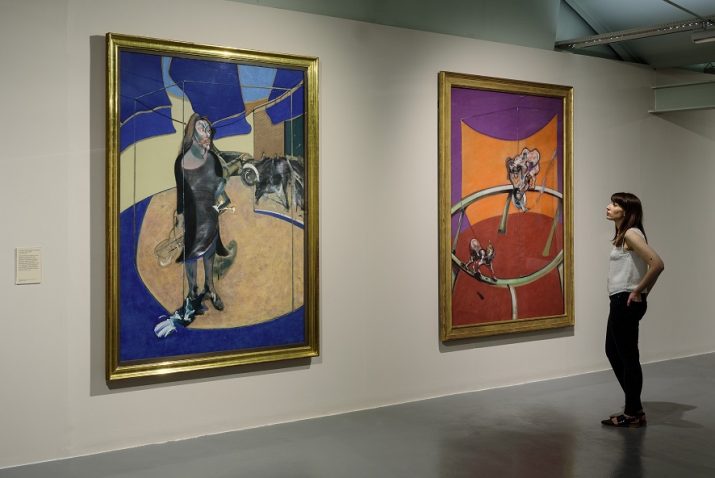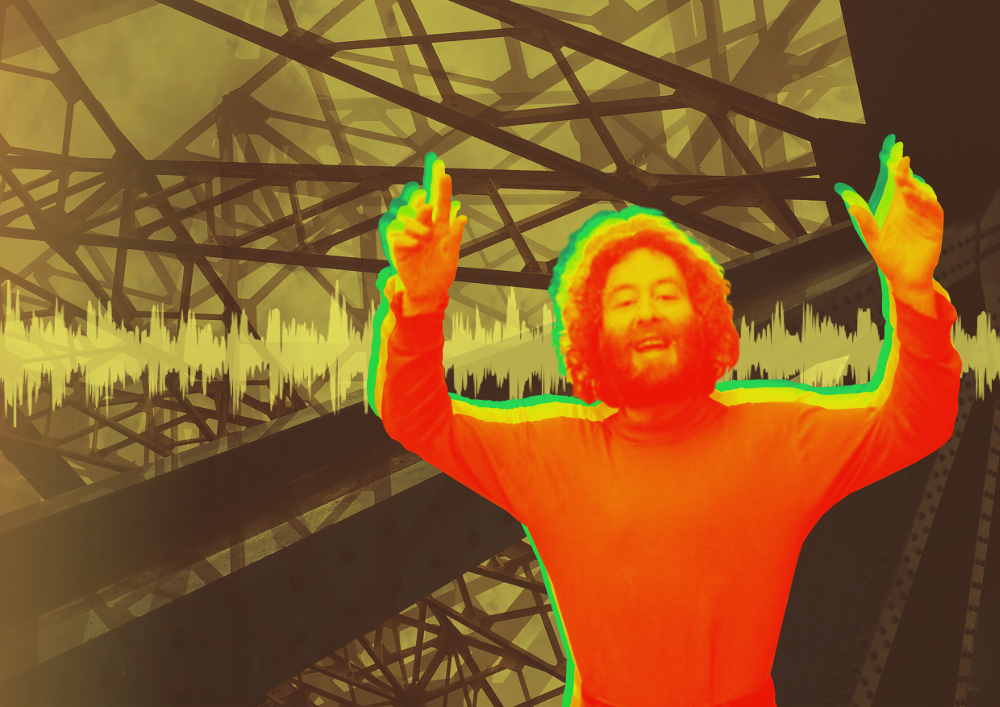Here is a street. In the street stands a woman.
This is the street as a bullring, as a stage set, as a theatre of distant despair. The woman waits alone, apparently trapped in an invisible box, but there’s no hint that she’s clamouring for escape. Out there, way beyond, there’s hubbub and movement and blur, but here in this elemental urban arena there’s just a woman, just a human, just a soul.
This is Portrait of Isabel Rawsthorne Standing in a Street in Soho by the artist Francis Bacon. You can see this painting at Tate Liverpool this summer, perhaps the finest work in an exhibition called Francis Bacon: Invisible Rooms. The show is rich with crouched and writhing forms, bodies balled like fists, mouths gaping and shrieking like portals to a personal kind of hell. But the Isabel Rawsthorne portrait is different. Not in spasm, not in pain, she stands upright and strong, facing down the turbulent spirits as they pass.
Francis Bacon barely needs an introduction. As one of the greatest British painters of the 20th century – one with true international appeal way beyond the greasy Soho streets in which he gossiped and sneered and drank – his reputation remains immense almost 25 years after his death. Dedicated to a singular figurative vision throughout the era of abstract domination, Bacon treated the human form like a cold slab of meat – one that twitched with a certain kind of animation, but not with a spirit of fulfilment or hope. His figures are isolated, enthroned, on display, and the way he chose to imprison his subjects in representational space is the focus of this enthralling Tate Liverpool show.
But who was Isabel Rawsthorne and what gives this 1967 portrait such a sense of defiance in a room full of anguish and hurt? I ask Lauren Barnes, Tate Liverpool’s assistant curator, to tell me a little more about both the woman and the painting; she reveals that although the picture is firmly located in 1960s Soho, Rawsthorne had roots closer to Tate Liverpool’s Albert Dock home.
 “Isabel Rawsthorne was very much part of the 60s Soho circle with Bacon,” says Barnes. “But her whole childhood and early years were in Liverpool. She was born in 1912 and studied at Liverpool School of Art, then she really established herself as an artist and artist’s model. As well as modelling for Bacon, she also modelled for Alberto Giacometti, and was very much part of that whole world, not just in London but in Paris as well.”
“Isabel Rawsthorne was very much part of the 60s Soho circle with Bacon,” says Barnes. “But her whole childhood and early years were in Liverpool. She was born in 1912 and studied at Liverpool School of Art, then she really established herself as an artist and artist’s model. As well as modelling for Bacon, she also modelled for Alberto Giacometti, and was very much part of that whole world, not just in London but in Paris as well.”
Rawsthorne’s life in pre-war Paris reads like a breathless novel set in the heart of the artistic avant-garde. Married to the Daily Express’s foreign correspondent Sefton Delmer, she travelled with Balthus, worked with André Derain and was painted by Picasso himself. As a socialist she visited Spain during the Civil War, and only fled Paris on the day the Germans arrived. Almost inevitably for such a character, it’s thought that she spent the war working as a spy.
Describing the painting, Barnes hints at the power it conceals.
“It’s about two metres tall so it really feels like the figure of Rawsthorne is almost life size. When you stand up close to it, she towers above you although she feels very much like she’s our scale. Bacon has used the paint in these big swooping gestures, so her figure emerges in this quite amazing way. She’s trapped in a cage that’s placed over the top of her, and she’s also positioned in a sweeping, curved arena. Then there’s this very mysterious object behind her which is potentially like a car and a crowd of people, or some commentators have said it’s a bull in a bullring, or even a bat. So there’s a huge amount of mystery to this painting.”
Barnes continues: “Bacon’s portraits of Rawsthorne are quite striking among his paintings of women because she’s very forthright and assertive, she’s absolutely not this reclining woman or a passive body.”
After the war, Rawsthorne reignited her own artistic explorations while switching periodically between Paris and London, but it was in Soho that her friendship with Bacon must have flourished.
Barnes explains: “There was this world of bars and pubs in Soho, such as the Colony Room and other venues, where people in a certain world would go to meet each other. It feels as though we don’t really have an equivalent these days.”
The reason that we don’t now have an equivalent, of course, is that we are free to buy a drink any time we want. Between 1915 and 1988, however, Britain’s curious licensing laws required pubs to close between 3pm and 6pm every day, and it was only in private members’ clubs such as those tucked into Soho’s sweaty nooks and crannies that London’s alcohol-fuelled actors, writers and artists could booze the daylight hours away.
 Bacon was one of the most celebrated Colony Room regulars, and the painting’s stated Soho location hints at that slumped and sozzled sunlight-dodging afternoon world. Not that there’s much that’s recognisably Soho up there on the canvas.
Bacon was one of the most celebrated Colony Room regulars, and the painting’s stated Soho location hints at that slumped and sozzled sunlight-dodging afternoon world. Not that there’s much that’s recognisably Soho up there on the canvas.
“The thing I find really interesting about this painting is that it’s the translation of a photograph. Bacon commissioned the photographer John Deakin to take a series of pictures in the mid-60s, giving very precise instructions about how the figures should be positioned. So in the photograph, Rawsthorne is standing in the street according to Bacon’s very specific instructions about setting, but then in the painting he removes the figure from the setting, only leaving a very small hint of the location.”
As this exhibition makes abundantly clear, Bacon had been using found photographs extensively for decades prior to the Rawsthorne portrait.
“In the 40s and 50s he was using images from boxing magazines and natural history books, or books about 20th century history,” says Barnes. “But it was at this moment in the 60s that he turned to John Deakin to actually commission photographs that he could use as sources. That was really quite a big step for him.”
Important though photography was as a source, Barnes says it also presented Bacon with an intellectual problem.
“One of the reasons that he’s hugely important is that he looked at painting – figurative painting in particular – and thought, why should we still make a painting when photography exists? One of his most important contributions was to really commit to painting and its possibilities in this world after photography.”
I stand close to the painting and think about the branching decisions that must have been involved in its creation, from big thoughts about structure and framing down to choices between swooping the brush this way or that. I gaze into Rawsthorne’s smudged and shadowed face with its fearsome pink blood pressure hue, and wonder at the strength of this Liverpool woman who strode into Europe and set about making her mark.
Not that Rawsthorne’s biography should necessarily be uppermost in my mind.
“In painting figures like these, Bacon wasn’t so much trying to communicate these people’s personalities. In a way they were becoming nameless figures, and if his dealer hadn’t given these descriptive titles to the works, he might not have labelled them as particular subjects.”
Barnes adds:  “For us, this painting is one of the most interesting treatments of space. Bacon was playing a very complicated game between distance and presence, and between surface and depth. On the surface you have these splodges of white paint that are directly squeezed from the tube, really protruding from the surface, but he’s also placing the figure at a certain distance and establishing that we’re not in the same space as her. So I think it’s one of the most interesting paintings in the show.”
“For us, this painting is one of the most interesting treatments of space. Bacon was playing a very complicated game between distance and presence, and between surface and depth. On the surface you have these splodges of white paint that are directly squeezed from the tube, really protruding from the surface, but he’s also placing the figure at a certain distance and establishing that we’re not in the same space as her. So I think it’s one of the most interesting paintings in the show.”
Francis Bacon: Invisible Rooms takes a familiar artist but asks an unfamiliar question. Instead of querying the human horror at the core of Bacon’s work, it asks why he presented his figures the way he did – in boxes, on platforms, behind rails. It reveals the thought and deliberation that went into deciding to frame his subjects in such a way – including the preparatory sketches that he always denied he made – and in doing so, it strips back his art to the bone.
But I can’t help being drawn back to this painting. Once of Liverpool, now of history, this woman imposes herself on Bacon’s canvas rather than curling into a ball of raw pain.
Across the gallery there may be molten bodies, stunted horrors and flailing limbs, but on the strength of this powerful picture, Isabel Rawsthorne was far too big a personality for all that.
What: Francis Bacon: Invisible Rooms
Where: Tate Liverpool
When: until September 18, 2016
More info: www.tate.org.uk/visit/tate-liverpool
Main Image: Portrait of Isabel Rawsthorne Standing in a Street in Soho 1967 (left) and After Muybridge – Woman Emptying a Bowl of Water and Paralytic Child on All Fours 1965 (right) by Francis Bacon, on display in Francis Bacon: Invisible Rooms at Tate Liverpool until 18 September 2016. © Tate Liverpool, Roger Sinek












